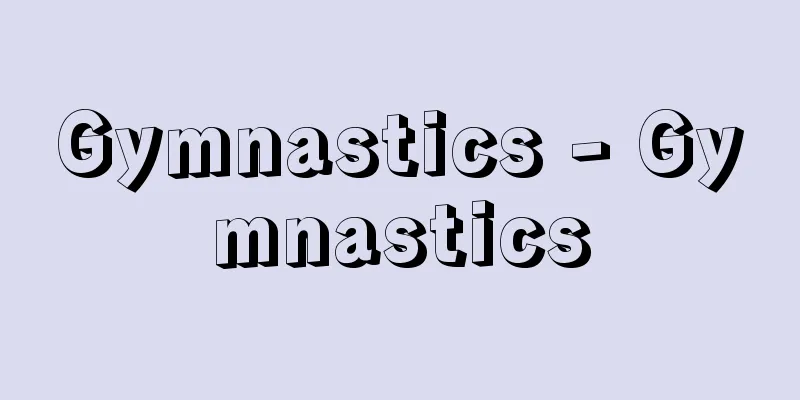Gymnastics - Gymnastics

|
It refers to all exercises that are performed using equipment. It is contrasted with unaided gymnastics, which is performed with bare hands, and apparatus gymnastics, which is performed with tools. Traditionally, apparatus gymnastics meant exercises in the German gymnastics system, such as the horizontal bar, parallel bars, rings, and pommel horse, but strictly speaking, all exercises that use equipment are apparatus gymnastics. In other words, in addition to the Swedish gymnastics system's rib bars, cross beams, hanging ropes, rope ladders, vaulting boxes, and balance beams, trampolines, which were developed in the United States and are becoming popular in Japan, also fall into the category of apparatus gymnastics. Mat exercises (rotational exercises performed using mats) are already considered apparatus exercises in Germany and other countries. [Tadao Kamisako] historyGymnastics using equipment was adopted in ancient Greece as a subject of combat training aimed at cultivating military abilities. Gymnastics for educational purposes emerged in the 19th century, when the German gymnast Jahn established a gymnastics hall in the Hasenheide Forest on the outskirts of Berlin and engaged in comprehensive training of gymnastics for young people using equipment such as the horizontal bar, parallel bars, pommel horse, and wooden horse, which paved the way for artistic gymnastics. Gymnastics then spread throughout Europe, primarily in Germany, and improvements were made to the equipment and technology evolved, developing into the artistic gymnastics of today. Currently, the official gymnastics events are the horizontal bar (men), rings (men), pommel horse (men), parallel bars (men), uneven bars (women), balance beam (women), vault (men and women), and floor exercise (men and women). [Tadao Kamisako] Japanese GymnasticsGymnastics was introduced to Japan at the beginning of the Meiji era. Gymnastics was first organized as a sport at the end of the Meiji era, and there is a record of a competition between Keio University, Azabu Junior High School, and Aoyama Normal School. In 1926 (Taisho 15), the gymnastics specifications were published, and exercises such as chin-ups, jumps, handstands, and turns were implemented nationwide as the main teaching materials for school physical education. As gymnastics became more popular and developed, competitions between universities also became more popular. In 1930 (Showa 5), the All Japan Gymnastics Federation (the predecessor of the Japan Gymnastics Association) was formed, and the organizational foundation of gymnastics was established. Gymnastics is an indispensable teaching material for physical education in elementary and junior high schools, as it improves the ability to control the body by strengthening muscle strength and cultivating dexterity, and also has a great psychological effect by cultivating courage, determination, and creativity. The equipment used in gymnastics is also used to correct poor posture. [Tadao Kamisako] [Reference] | |Source: Shogakukan Encyclopedia Nipponica About Encyclopedia Nipponica Information | Legend |
|
器械を使用して行うすべての運動をいう。素手で行う徒手(としゅ)体操、用具を持って行う手具(しゅぐ)体操と対比される。従来、器械体操といえば、鉄棒、平行棒、つり輪、あん馬などドイツ体操系統の運動を意味したが、正確には器械を使用して行う運動はすべて器械体操である。つまり、スウェーデン体操系統の肋木(ろくぼく)、横木、つり縄、つり棒、縄梯子(なわばしご)、跳び箱、平均台などのほか、アメリカで発達し日本でも普及しつつあるトランポリンも器械体操に入る。マット運動(マットを使用して行う転回運動)にしても、ドイツその他の国ではすでに器械運動として扱われている。 [上迫忠夫] 歴史器械を使用する運動は、古代ギリシア時代、軍事能力養成を目的とした戦技訓練の課目として取り上げられている。教育的な目的をもって器械体操が登場したのは19世紀に入ってからで、ドイツの体操家ヤーンが、ベルリン郊外ハーゼンハイデの森に体操場を設け、青少年のために鉄棒、平行棒、あん馬、木馬など器械運動の総合的訓練に従事、これが体操競技の基礎を開いた。その後、器械体操はドイツを中心にヨーロッパ各国に普及し、器械に改良が加えられ、技術も進歩して今日の体操競技に発展した。 現在、体操競技の正式種目は、鉄棒(男)、つり輪(男)、あん馬(男)、平行棒(男)、段違い平行棒(女)、平均台(女)、跳馬(男女)、ゆか運動(男女)である。 [上迫忠夫] 日本の器械体操日本に体操が輸入されたのは明治の初めである。器械体操が競技として初めて組織的に行われたのは明治末期で、慶応義塾、麻布中学校、青山師範学校の間で争われた対抗競技の記録がある。1926年(大正15)に公布された体操要目により、懸垂、跳躍、倒立、転回などの運動が、学校体育の主要教材として全国的に実施された。器械体操が普及発展するにつれて、各大学の対抗競技も盛んになった。1930年(昭和5)全日本体操連盟(日本体操協会の前身)が結成され、体操競技の組織的基盤を確立した。器械体操は筋力の強化、巧緻(こうち)性の養成など身体の支配能力を高めるとともに、勇気、決断力、創造性の育成など精神的効果も大きく、小・中学校の体育では欠かせない重要教材の一つである。また、器械体操に使用される器具は、不良姿勢の矯正にも利用される。 [上迫忠夫] [参照項目] | |出典 小学館 日本大百科全書(ニッポニカ)日本大百科全書(ニッポニカ)について 情報 | 凡例 |
Recommend
Tye, C. (English spelling) TyeC
…Henry VIII favored composers such as R. Fayrfax ...
Plunder - Plunder
In the Middle Ages, it meant taking weapons, armor...
Mrs. Simpson - Simpson, Wallis Warfield (Duchess of Windsor)
Born: June 19, 1896 in Pennsylvania [Died] April 2...
Abnormal experience response
...However, in the formation of generally seen ps...
Jasminum gracillimum (English spelling) Jasminum gracillimum
…[Murata Gen]. … *Some of the terminology that me...
《Kissaben》 - Kissaben
…Kashin brought about a breakthrough in the world...
Otsu Road
An ancient road running east to west across the Ka...
Green buds - Aome
〘noun〙① The newly sprouted green shoots of plants....
Minamoto no Toru - Minamoto no Toru
Year of death: August 25, 7th year of Kanpei (Sept...
Bubble Viscometer
...There are parallel plate viscometers, plate vi...
Great Salt Lake
A salt lake in northwestern Utah, in the western U...
Kogure Ryotaro - Kogure Ryotaro
Mountaineer. Born in Gunma Prefecture, he dropped ...
Deming Prize - Deming Prize
The award was established in 1951 by the Union of...
Shakubuku -
A method of teaching in Buddhism. The opposite of...
Karnataka Music - Karnataka Music
Classical music of South India. With the emergence...









